Refined Termination Letters: 29 Expert Templates for Effective Project Closure
Embark on a transformative journey into the art of communication with “Project Termination Letters.” At our celestial haven, we understand the significance of crafting effective and professional letters that resonate with stakeholders and leave a lasting impact. No ordinary website, we offer a universe of invaluable resources, guiding you through the intricacies of different scenarios. From celestial templates to ethereal best practices, our unique approach empowers you to communicate with empathy, clarity, and finesse. Prepare to ascend astral heights in your communication endeavors, as we unveil the secrets to celestial. Step into the cosmos of “Project Termination Letters,” and let the stars of your communication prowess shine bright!
Best Practices for Writing
- Clarity and Brevity: Keep the letter clear, concise, and to the point. Avoid unnecessary details and use straightforward language to convey the message effectively.
- Professional Tone: Maintain a professional and respectful tone throughout the letter. Avoid emotional language or personal biases.
- Specific Reasons: Clearly state the reasons for termination to provide stakeholders with a comprehensive understanding of the decision.
- Acknowledge Contributions: Express appreciation for the efforts and contributions of the team and stakeholders, even if the project did not reach its desired outcome.
- Show Empathy: Demonstrate empathy towards the impact of stakeholders and assure them that their concerns have been considered.
- Address Legal Obligations: Ensure the letter addresses any legal or contractual obligations related to the termination and compliance requirements.
- Offer Next Steps: Outline any relevant steps or procedures to follow after the project closure. Provide information on closeout procedures or responsibilities transition.
- Timely Communication: Deliver the letter promptly to inform stakeholders about the termination as soon as the decision is finalized.
- Proofreading and Editing: Thoroughly proofread the letter to avoid spelling errors, grammar mistakes, or unclear language.
- Use Letterhead or Official Format: Present the letter on official company letterhead or use a standard business format to enhance its professional appearance.
- Consistency with Branding: Ensure the letter adheres to the organization’s branding guidelines to maintain brand consistency.
- Secure Delivery: Use a secure and confidential delivery method for the letter, especially when sensitive information is included.
- Follow-Up Support: Offer support or assistance to stakeholders during the transition period to address any queries or concerns they may have.
- Stakeholder Communication: Inform all relevant stakeholders about the termination to avoid misinformation or confusion.
- Maintain Confidentiality: Ensure the letter is distributed only to the intended recipients to maintain confidentiality.
Common Mistakes to Avoid
When composing letters, customers should avoid the following common mistakes to ensure effective and professional communication:
- Ambiguous Language: Using unclear or vague language can lead to misunderstandings and confusion about the reasons for termination.
- Blaming Language: Avoid blaming or pointing fingers at specific individuals or teams for the project’s failure, as it can create hostility and hinder future collaborations.
- Lack of Empathy: Failing to show empathy towards the impact of the termination on stakeholders can damage relationships and trust.
- Omitting Reasons: Not providing clear and specific reasons for termination can leave stakeholders in the dark and lead to further questions.
- Insufficient Detail: Providing inadequate information about the termination can lead to misconceptions and doubts about the decision.
- Unprofessional Tone: Using an unprofessional or emotional tone can undermine the credibility of the letter and the organization.
- Ignoring Legal Obligations: Neglecting to address legal obligations, contractual requirements, or regulatory compliance can lead to potential legal issues.
- Neglecting Team Appreciation: Failing to acknowledge the efforts and contributions of the team and stakeholders can create dissatisfaction and discourage future collaborations.
- Lack of Clarity on Next Steps: Not outlining clear next steps or procedures after termination can leave stakeholders uncertain about what happens next.
- Leaving Out Contact Information: Forgetting to include contact details for further inquiries can hinder communication and leave stakeholders without a point of contact.
- Overlooking Stakeholder Communication: Neglecting to inform all relevant stakeholders about the termination can lead to misinformation and misunderstanding.
- Ignoring Repercussions: Not addressing the potential consequences for stakeholders and the organization can lead to unforeseen challenges.
- Excessive Detail: On the other hand, providing excessive or unnecessary details can overwhelm recipients and dilute the primary message.
- Neglecting Follow-Up Support: Failing to offer support or assistance to stakeholders during the transition period can leave them feeling abandoned.
#1: Project Completion Notice
The Project Completion Notice is a formal communication sent by the manager or team lead. It announces the successful conclusion of the project. The notice highlights achievements, outcomes, and meeting objectives. It acknowledges the efforts of the team members and expresses gratitude to stakeholders. It includes details about the impact and may provide results to the organization or community. The notice signifies the formal handover of results and documentation for a smooth transition to the next phase or project.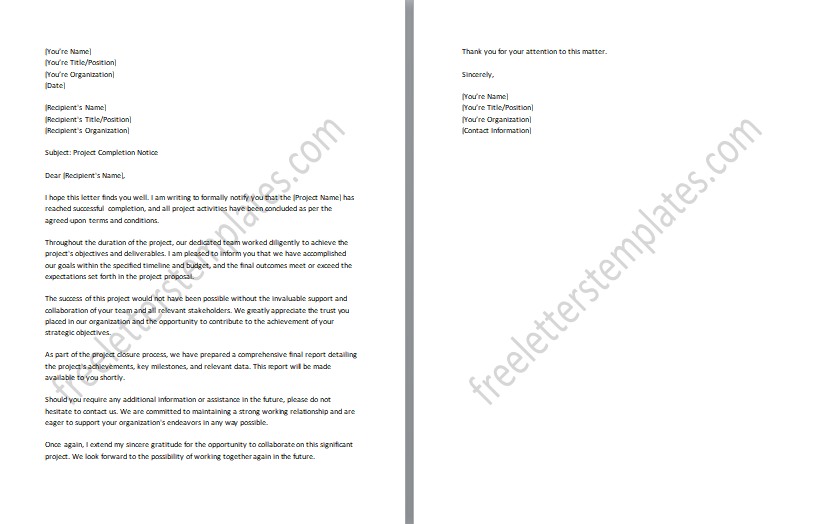
#2: Budgetary Constraints Termination Letter
The Budgetary Constraints Letter is a formal communication. It informs stakeholders about project termination. The reason is financial limitations or budget constraints. The letter states that resources are insufficient for completion. Efforts were made to find alternative funding or cost-cutting measures. However, financial viability cannot be ensured. The letter expresses regret and gratitude for the team’s efforts. The organization remains committed to pursuing others within available financial resources. The letter aims to be transparent, professional, and communicative. It informs stakeholders about the reasons for termination and manages expectations for the future.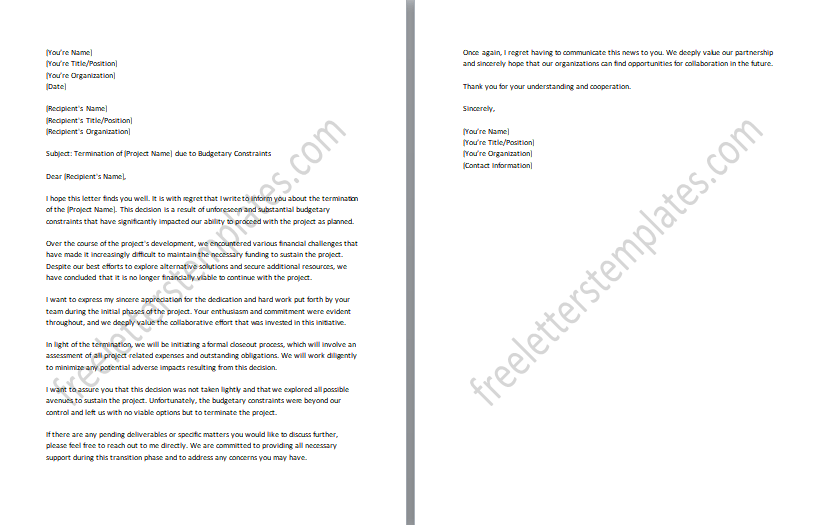
#3: Scope Modification Project Closure Notice
The Scope Modification Project Closure Notice is a formal communication. It announces closure due to significant scope modifications. Changes in objectives, deliverables, or requirements have occurred. The original plan is no longer feasible or aligned with organizational goals. Despite efforts to adapt, success cannot be ensured. The notice expresses gratitude to the team for their efforts. It acknowledges stakeholder collaboration throughout the project. Lessons learned will be valuable for future endeavors. The closure notice is transparent and informative. It helps stakeholders understand the reasons for closure and the importance of adapting to evolving circumstances for successful outcomes.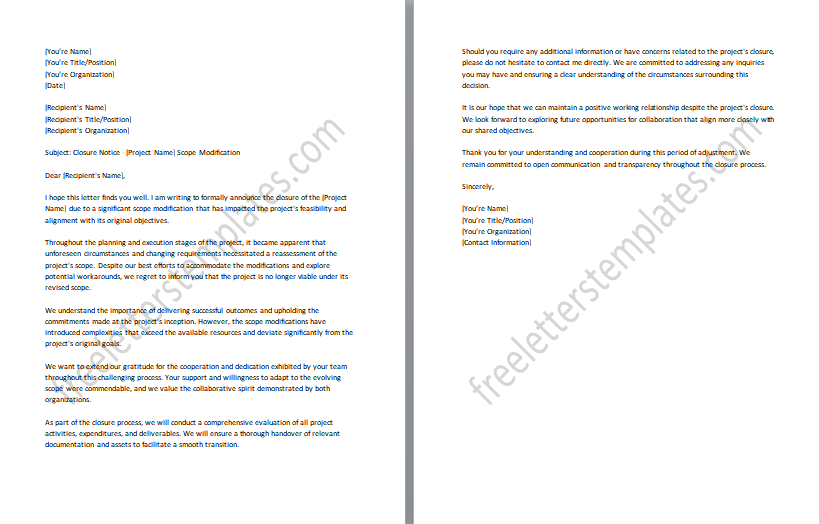
#4: Market Shift Project Termination Letter
The Market Shift Project Termination Letter is a formal communication. It announces due to significant market shifts. Changes in market conditions, consumer preferences, or competition have made the project less relevant or viable. The letter appreciates the team’s dedication and collaboration of stakeholders. It assures a commitment to monitoring trends and exploring new opportunities in the dynamic market. The letter aims to be transparent and respectful, ensuring stakeholders understand the reasons for termination and the organization’s agile approach to market changes.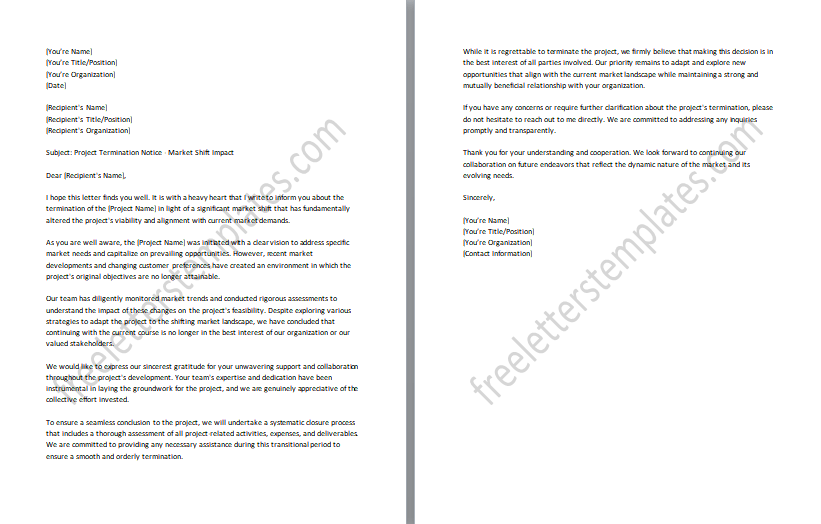
#5: Organizational Restructuring Project Closure Notice
The Organizational Restructuring Project Closure Notice is a formal communication. It announces closure due to organizational restructuring. Changes in structure, priorities, or direction have impacted the relevance. Efforts to realign it were made, but continuing is no longer in the organization’s best interest. The notice expresses gratitude to the team and acknowledges stakeholder collaboration. Valuable lessons learned will inform future initiatives. The closure notice is transparent and informative, reflecting the organization’s commitment to optimizing resources and strategic alignment.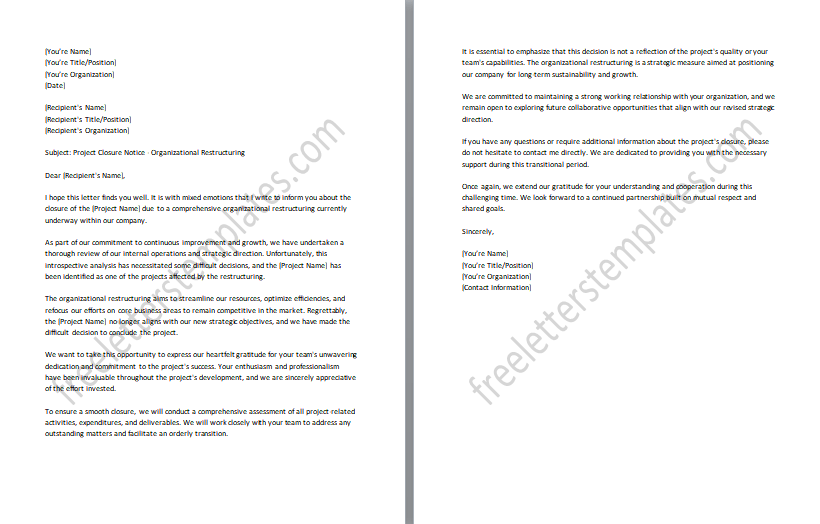
#6: Legal Issues Project Termination Letter
The Legal Issues Project Termination Letter is formal. It announces project termination due to legal issues. Unforeseen complexities, disputes, or regulatory challenges have arisen. Continuing is impractical or risky. Efforts to address the problems were made. They are beyond the scope and resolution. The letter regrets the decision and appreciates the team’s dedication. Stakeholder collaboration is acknowledged. The initial intent was to execute the successfully. The organization remains committed to legal compliance and exploring new projects. The letter aims to be transparent and responsible. Stakeholders understand the reasons for termination and the commitment to legal integrity.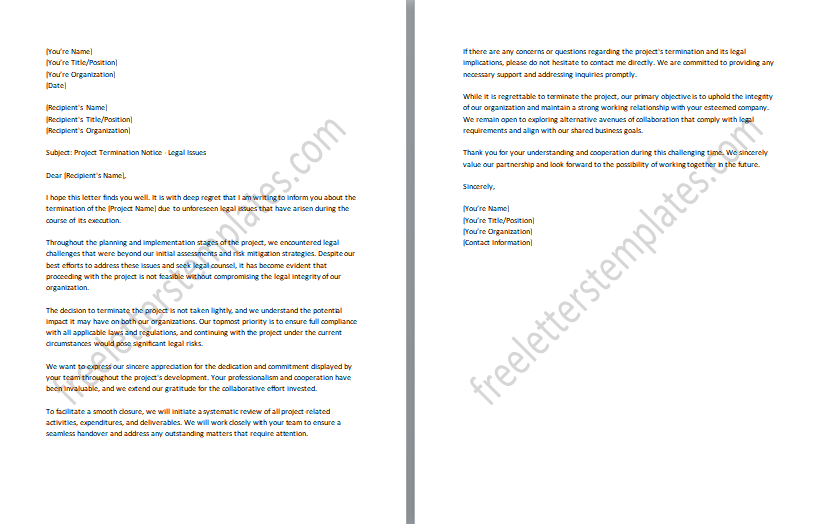
#7: Technological Advancements Project Closure Notice
The Technological Advancements Project Closure Notice is a formal communication. It announces closure due to technological advancements. Recent developments made the original objectives or methodologies outdated. Efforts to adapt were made, but success cannot be ensured in the rapidly evolving technological landscape. The notice appreciates the project team and acknowledges stakeholder collaboration. Valuable insights gained will inform future initiatives with the latest technological advancements. The closure notice aims to be transparent and informative. Stakeholders understand the reasons for closure and the commitment to embracing cutting-edge technologies in future endeavors.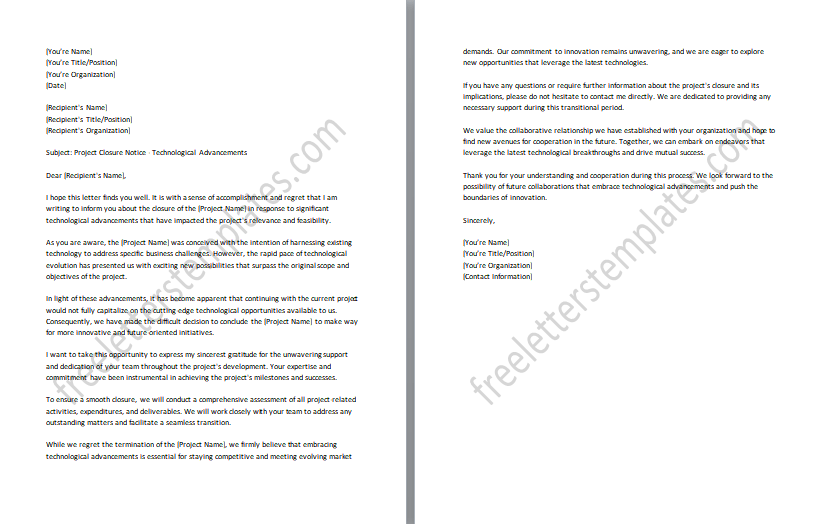
#8: Resource Allocation Termination Letter
The Resource Allocation Termination Letter is formal. It announces project termination due to inadequate or reallocated resources. Changes in priorities or constraints led to the decision. The letter regrets the closure and appreciates the team’s efforts. Stakeholder collaboration is acknowledged. The organization remains committed to optimizing resource allocation and exploring new projects. The letter aims to be transparent and responsible, ensuring stakeholders understand the reasons and the commitment to prudent resource management for future endeavors.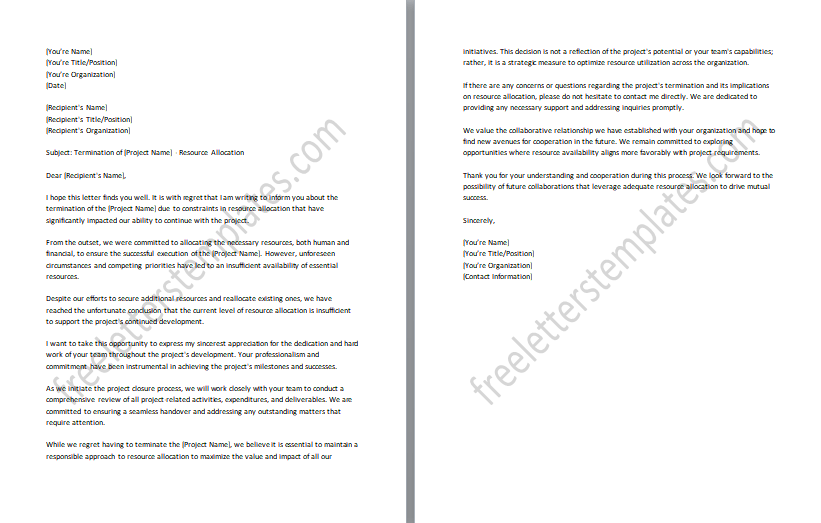
#9: Client Decision Project Closure Notice
The Client Decision Project Closure Notice is formal. It informs about closure due to the client’s decision. The client has chosen to discontinue or suspend the project. The notice regrets the outcome and appreciates the team’s dedication. Stakeholder collaboration is acknowledged. The initial intent was to deliver a successful project. The organization remains committed to supporting the client’s decision. New opportunities for the future will be explored. The notice aims to be transparent and respectful. Stakeholders understand the reasons for closure and the importance of aligning with the client’s needs for successful outcomes.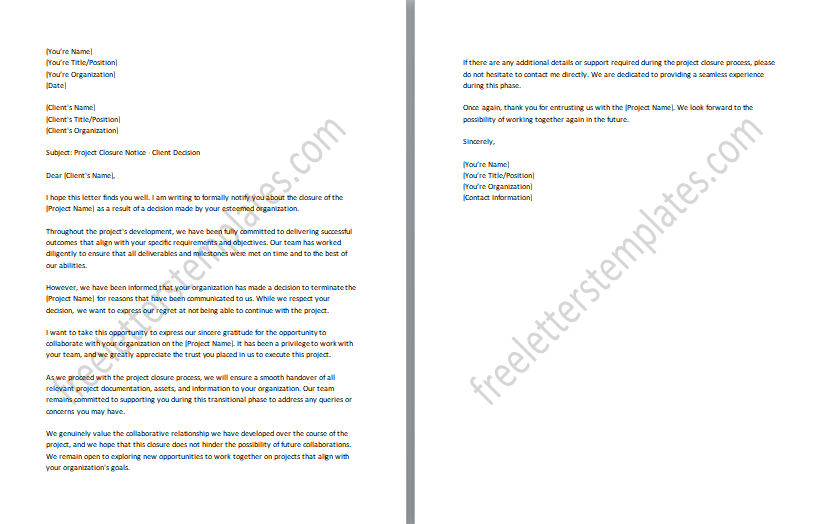
#10: Force Majeure Project Termination Letter
The Force Majeure Project Termination Letter is formal. It announces projects due to force majeure circumstances. Unforeseen events beyond the organization’s control have made the impossible to continue. The letter regrets the decision and appreciates the team’s dedication. Stakeholder collaboration is acknowledged. The initial intent was to execute the successfully. The organization remains committed to addressing the consequences and exploring new opportunities in the future. The letter aims to be transparent and responsible, ensuring stakeholders understand the reasons for termination and the commitment to navigate challenges professionally.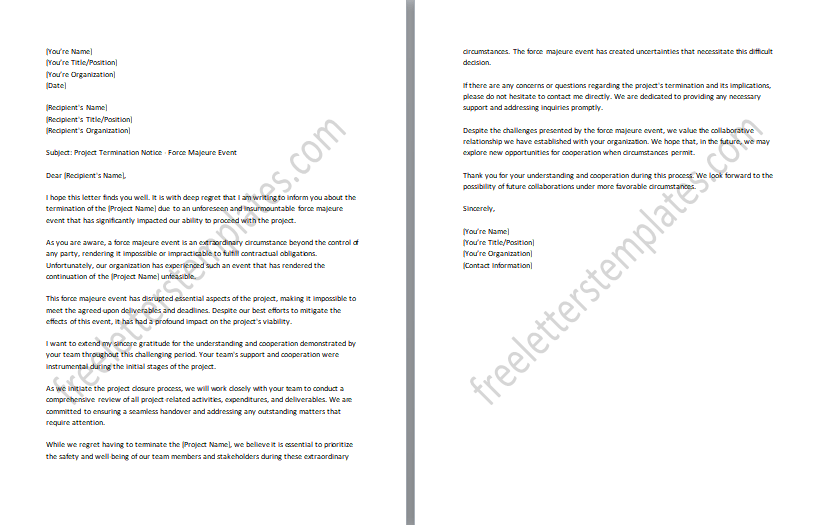
#11: Contractor Performance Termination Notice
The Contractor Performance Termination Notice is formal. It informs the contractor due to unsatisfactory performance. Despite efforts to address issues, standards were not met. The decision followed a careful evaluation of performance history and impact. The notice regrets the termination and emphasizes performance expectations. It may include contractual obligations or remedial actions required. The notice aims to be clear and professional, ensuring the contractor understands the reasons and the importance of reliable and high-quality performance in all business engagements.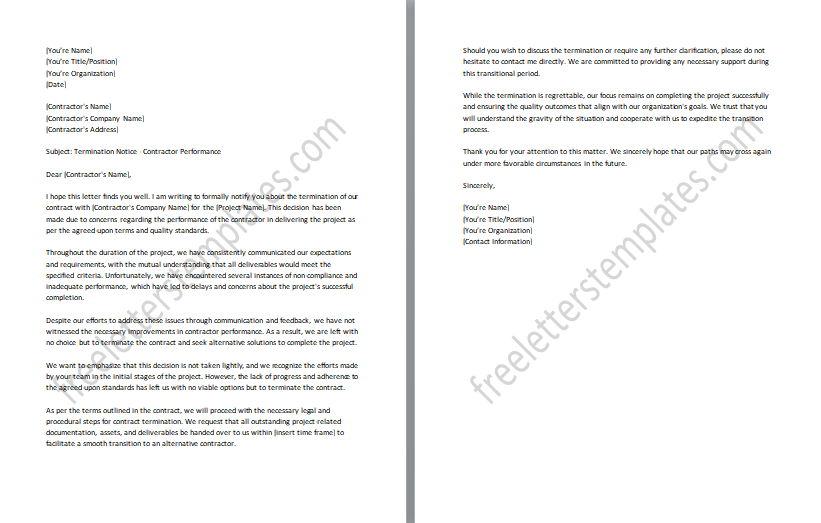
#12: Team Dissolution Project Closure Letter
The Team Dissolution Project Closure Letter is formal. It informs about closure due to the team’s dissolution. Changes in organizational structure or resource reallocation led to the decision. The project cannot continue without the dedicated team members. The letter regrets the decision and appreciates the team’s dedication. Stakeholder collaboration is acknowledged. The initial intent was to deliver a successful project. The organization remains committed to exploring new opportunities. The letter aims to be transparent and respectful, ensuring stakeholders understand the reasons for closure and the commitment to optimize team structures for successful project execution in the future.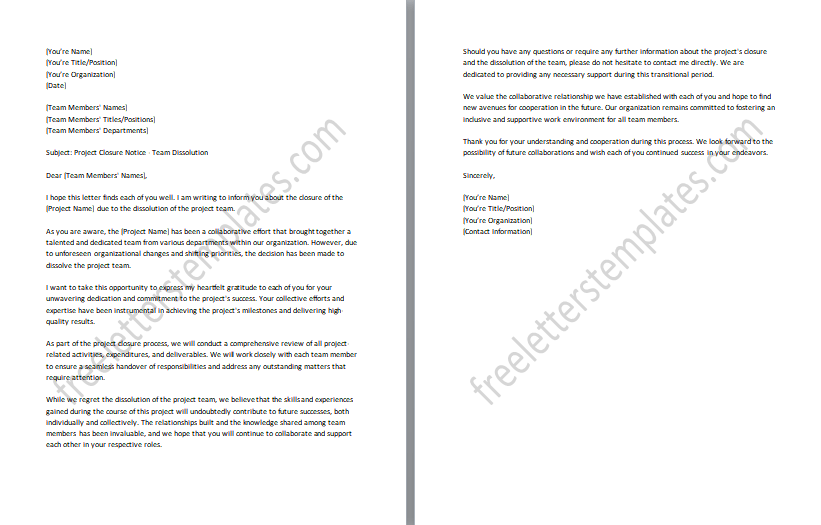
#13: Stakeholder Consensus Termination Notice
The Stakeholder Consensus Notice is formal. It informs due to the lack of stakeholder consensus. Efforts were made to gather input, address concerns, and align interests. The decision values stakeholder collaboration and unanimous support. The notice regrets the outcome and appreciates all stakeholders’ efforts. The organization remains committed to seeking common ground and exploring new opportunities with widespread consensus in future projects. The notice aims to be transparent and collaborative, ensuring stakeholders understand the reasons for termination and the commitment to fostering collective agreement in future initiatives.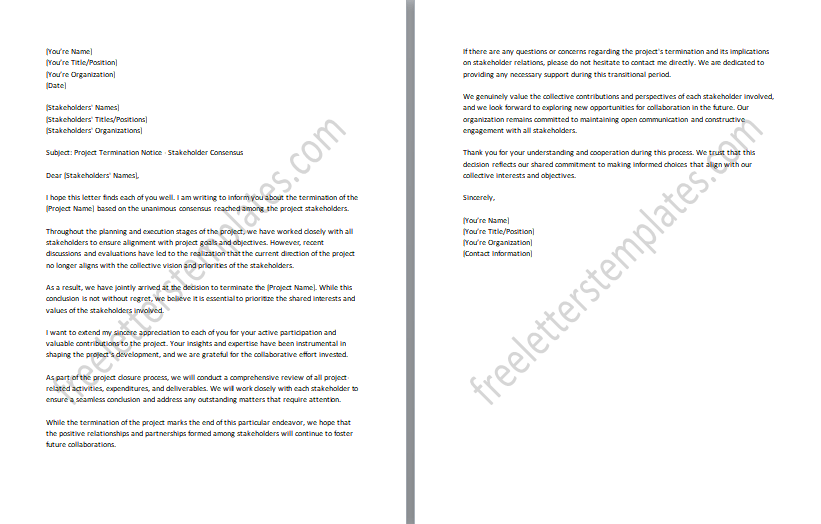
#14: Mergers and Acquisitions Project Closure Letter
The Mergers and Acquisitions Project Closure Letter is formal. It informs about closure due to a merger or acquisition. The recent changes in organizational structure and priorities make continuation impractical. The decision considers fit with the new objectives. The letter appreciates the team’s efforts and dedication. Stakeholder collaboration is acknowledged. The initial intent was to deliver a successful project. The organization remains committed to integrating the acquired or merged entities. Maximizing synergies is a priority. Plans to explore new projects aligned with the updated strategic direction are communicated.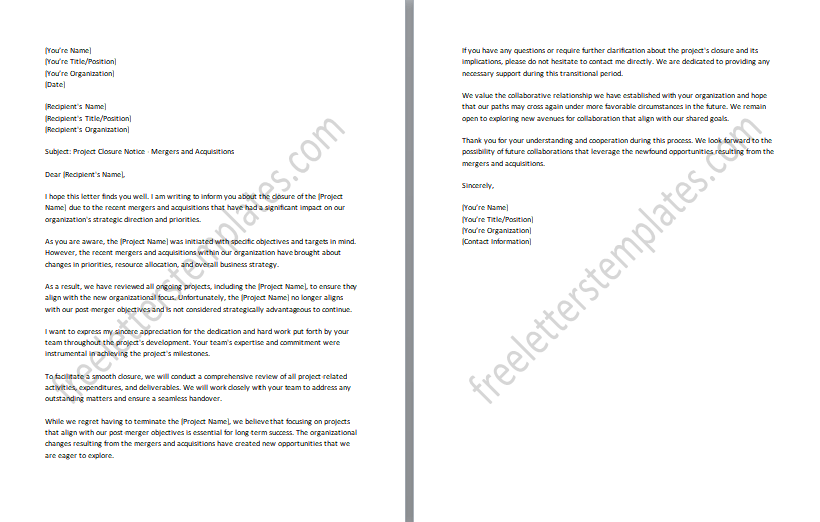
#15: Lack of Support Termination Notice
The Lack of Support Termination Notice is formal. It informs about project termination due to insufficient support. Despite efforts to garner backing from stakeholders, the necessary resources and cooperation were lacking. The decision considers the progress and the impact of the lack of support. The notice regrets the outcome and appreciates the team’s dedication. Stakeholder collaboration is acknowledged. The initial intent was to deliver a successful project. The organization remains committed to pursuing this with robust support and alignment. Insights into areas for improvement in garnering support for future initiatives may be offered.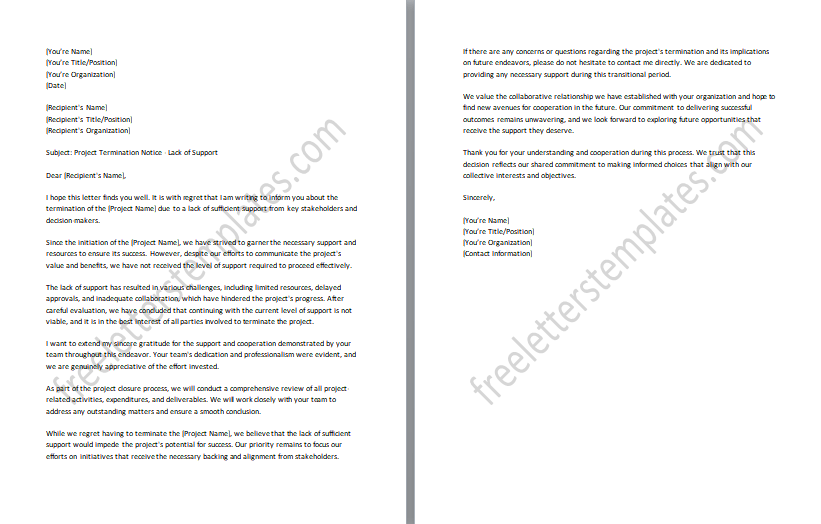
#16: Political Factors Project Termination Letter
The Political Factors Project Termination Letter is formal. It informs due to political factors. Changes in the political landscape, policies, or regulations impact feasibility. Despite efforts, continuing is no longer practical. The decision considers potential risks and implications. The letter regrets the termination and appreciates the team’s dedication. Stakeholder collaboration is acknowledged. The initial intent was to execute the successfully. The organization remains committed to exploring new opportunities when the political climate is conducive.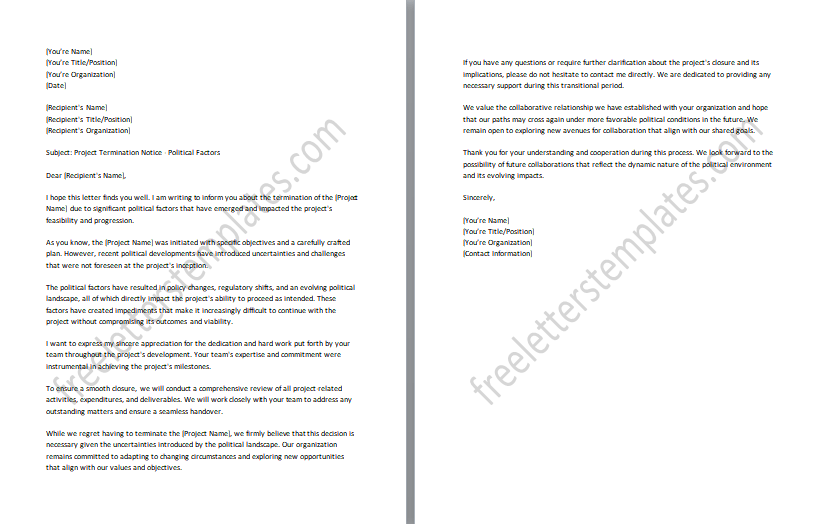
#17: Intellectual Property Issues Closure Notice
The Intellectual Property Issues Closure Notice is formal. It informs about project closure due to intellectual property issues. Legal or ethical concerns have arisen. Continuing is impractical or risky. Necessary permissions couldn’t be secured. The decision considers legal implications and potential consequences. The notice regrets the outcome and appreciates the team’s dedication. Stakeholder collaboration is acknowledged. The initial intent was to deliver a successful project. The organization remains committed to upholding ethical and legal integrity. Plans to explore new projects without similar challenges are communicated.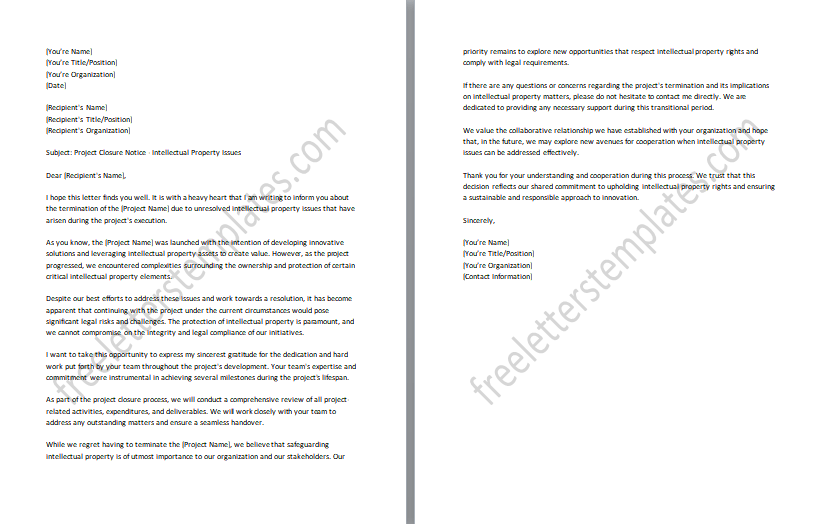
#18: Contractual Obligations Termination Letter
The Contractual Obligations Termination Letter is formal. It informs about projects due to unfulfilled contractual obligations. Unforeseen circumstances, financial constraints, or operational challenges make continuation impractical. The decision considers ethical and professional conduct. The letter regrets the termination and appreciates the team’s dedication. Stakeholder collaboration is acknowledged. The initial intent was to fulfill all contractual commitments. The organization remains committed to addressing the implications responsibly and ethically. Plans to explore new projects that align with capacity are communicated.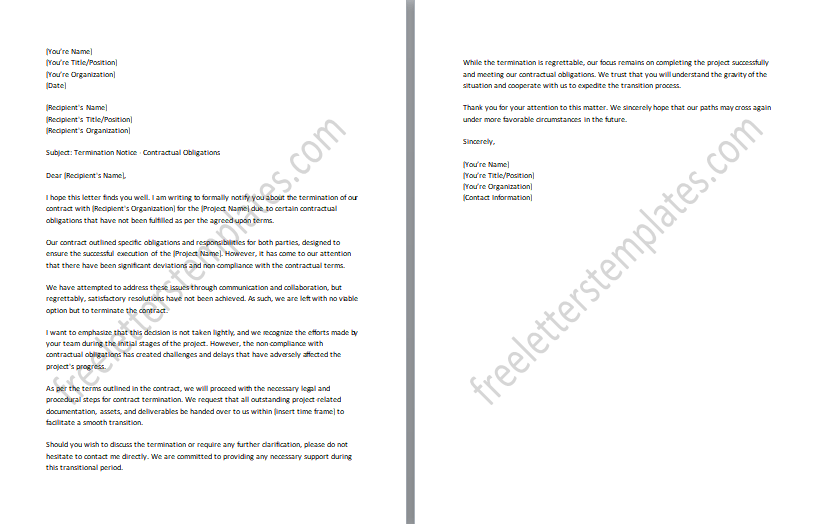
#19: Ethical Concerns Project Closure Notice
The Ethical Concerns Project Closure Notice is formal. It informs about closure due to ethical concerns. Raised considerations make continuation untenable. The decision considers ethical implications and reputational risks. The notice regrets the outcome and appreciates the team’s dedication. Stakeholder collaboration is acknowledged. The initial intent was to execute the responsibility. The organization remains committed to upholding ethical principles and integrity. Plans to explore alternative projects aligning with ethical standards are communicated. The letter aims to be transparent and responsible, ensuring stakeholders understand the reasons for termination and the commitment to making ethical decisions in line with organizational values and standards.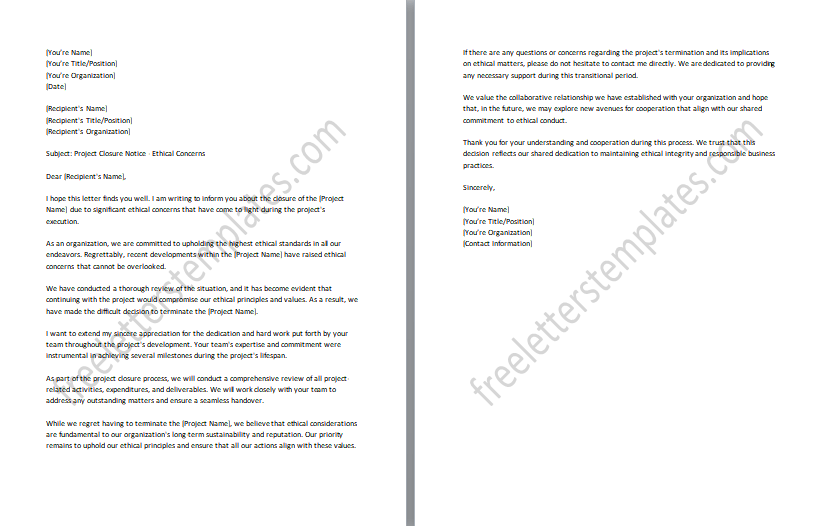
#20: Competition Project Termination Letter
The Competition Project Letter is formal. It informs about projects due to intense competition. Market dynamics, competitive pressures, or industry changes made sustaining a competitive advantage challenging. The decision considers the competitive position and feasibility. The letter regrets the termination and appreciates the team’s dedication. Stakeholder collaboration is acknowledged. The initial intent was to succeed in a competitive environment. Plans to leverage insights gained for innovation and growth are communicated. The letter aims to be transparent and strategic, ensuring stakeholders understand the reasons for termination and the commitment to adapting to competitive challenges for sustainable success.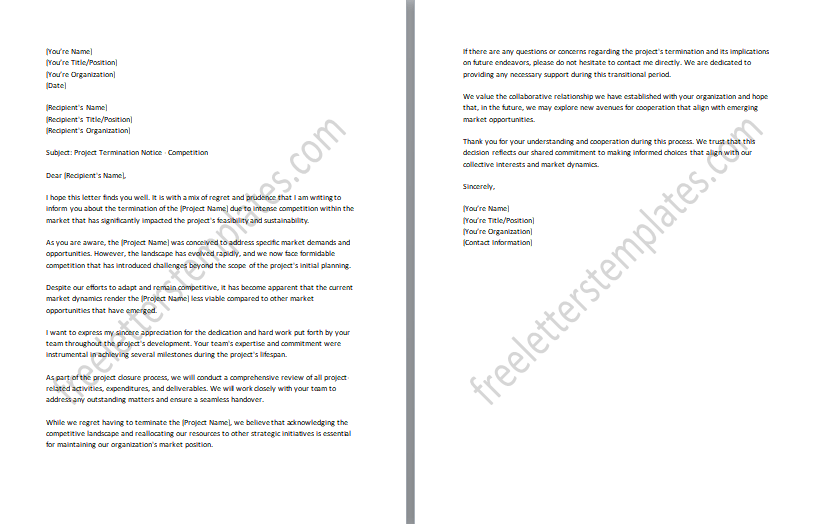
#21: Economic Recession Closure Notice
The Economic Recession Closure Notice is a formal communication informing stakeholders about project closure due to the impact of an economic downturn. The decision considers feasibility and financial sustainability amidst the recession. The notice expresses regret and appreciation for the team’s dedication. Stakeholder collaboration is acknowledged, and the initial intent to navigate the challenging economic conditions is recognized. The organization remains committed to responsible financial management and exploring new projects once economic conditions improve. The letter aims to be transparent, responsible, and dedicated to weathering economic challenges for sustainable growth in the future.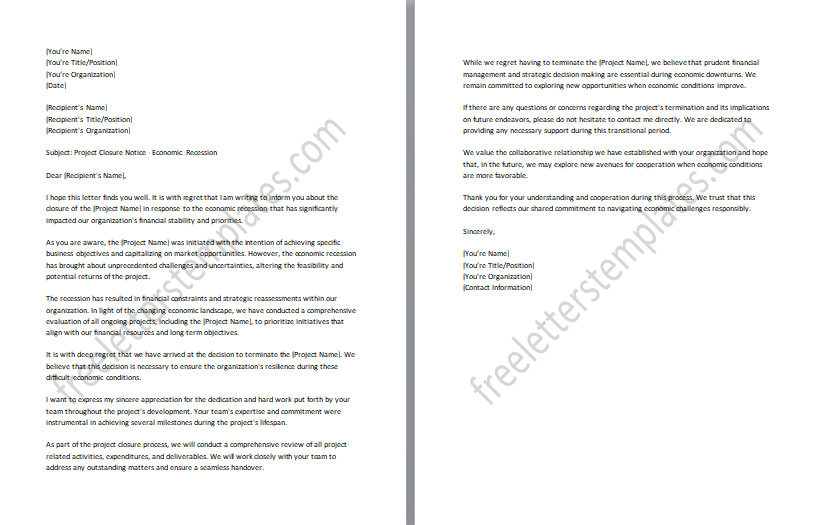
#22: Health and Safety Termination Letter
The Health and Safety Termination Letter is a formal communication announcing project closure due to emerging health and safety concerns. Unforeseen health risks, safety hazards, or regulatory requirements have rendered the unsafe or impractical to continue. The letter expresses regret for the termination and appreciation for the team’s dedication. Stakeholder collaboration is acknowledged, along with the initial intent to execute the project with utmost safety. The organization remains committed to prioritizing health and safety in all operations. Plans to address identified concerns and explore new projects once risks are mitigated are communicated.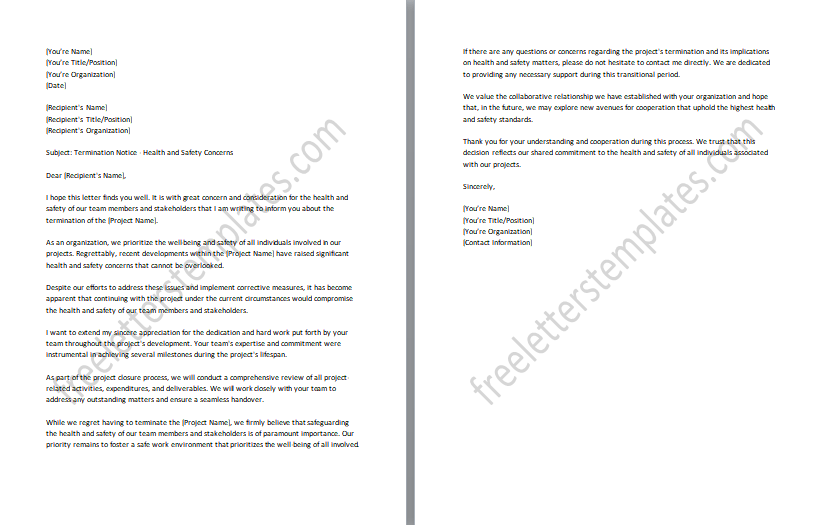
#23: Alignment with Strategic Goals Notice
The Alignment with Strategic Goals Notice is a formal communication informing stakeholders about project closure due to a lack of alignment with strategic goals. The decision considers the project’s fit with the organization’s strategic roadmap. The notice regrets the outcome and appreciates the team’s dedication. Stakeholder collaboration is acknowledged, along with the initial intent to contribute to strategic objectives. The organization remains committed to pursuing initiatives in line with its strategic direction. Insights gained from the project will inform future endeavors driving sustainable growth and success aligned with strategic goals. The letter aims to be transparent and forward-looking, ensuring stakeholders understand the reasons for termination and the dedication contributing to the organization’s strategic success.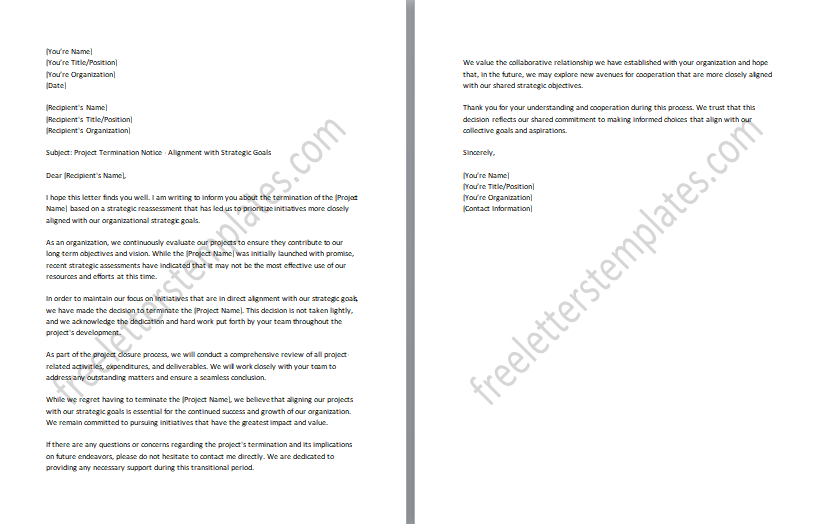
#24: Technological Obsolescence Project Termination Letter
The Technological Obsolescence Project Letter is formal. It informs about due to technological obsolescence. Advancements in technology or industry changes have made original objectives outdated. Despite efforts to adapt, this cannot achieve desired outcomes. The decision considers feasibility and relevance in the current technological context. The letter regrets the termination and appreciates the team’s dedication. Stakeholder collaboration is acknowledged. The initial intent was to leverage technology for success. The organization remains committed to embracing cutting-edge technologies. Exploring new projects aligned with the latest advancements is planned.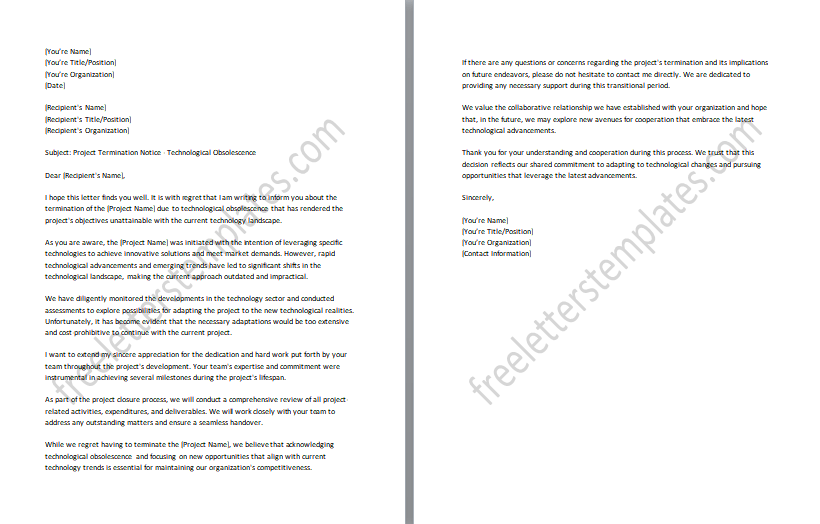
#25: Schedule Delays Termination Notice
The Schedule Delays Notice is formal. It informs about project closure due to persistent schedule delays. Efforts to mitigate delays were made. Unforeseen challenges, resource constraints, or external factors caused significant delays. The decision considers the timeline and impact on business objectives. The notice regrets the termination and appreciates the team’s dedication. Stakeholder collaboration is acknowledged. Better management practices will be implemented in the future. Plans to explore new projects with achievable timelines are communicated. The letter aims to be transparent and accountable, ensuring stakeholders understand the reasons for termination and the dedication to delivering on schedule in the future.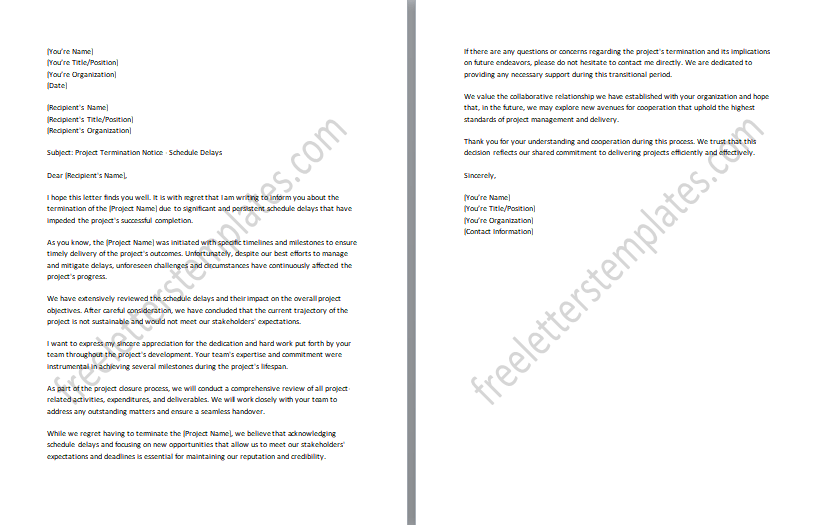
#26: External Dependency Project Closure Letter
The External Dependency Closure Letter is formal. It informs about closure due to external dependencies. Factors or resources beyond the organization’s control affected the project. Efforts to address dependencies were made. However, the project cannot proceed without resolving external factors. The decision considers feasibility and the impact of dependencies. The letter regrets the termination and appreciates the team’s dedication. Stakeholder collaboration is acknowledged. The initial intent was to navigate external dependencies successfully. The organization remains committed to exploring new projects with manageable dependencies and greater control over critical factors.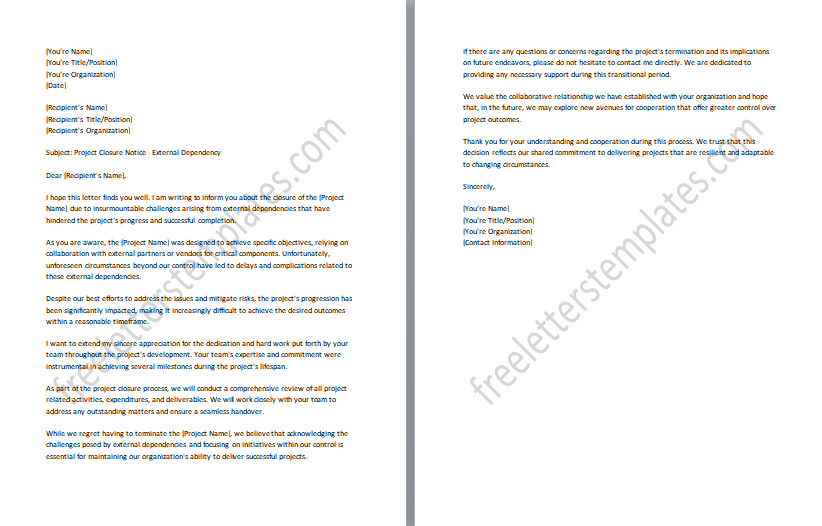
#27: Withdrawal of Funding Termination Letter
The Withdrawal of the Funding Letter is formal. It informs about termination due to funding withdrawal. Changes in financial priorities or resource reallocation led to the decision. Efforts to secure funding or alternatives were made. This cannot continue without sufficient financial backing. The decision considers financial viability and resource allocation. The letter regrets the termination and appreciates the team’s dedication. Stakeholder collaboration is acknowledged. The initial intent was to execute the project with adequate funding. The organization remains committed to prudent financial management. Exploring new projects aligned with available resources is planned.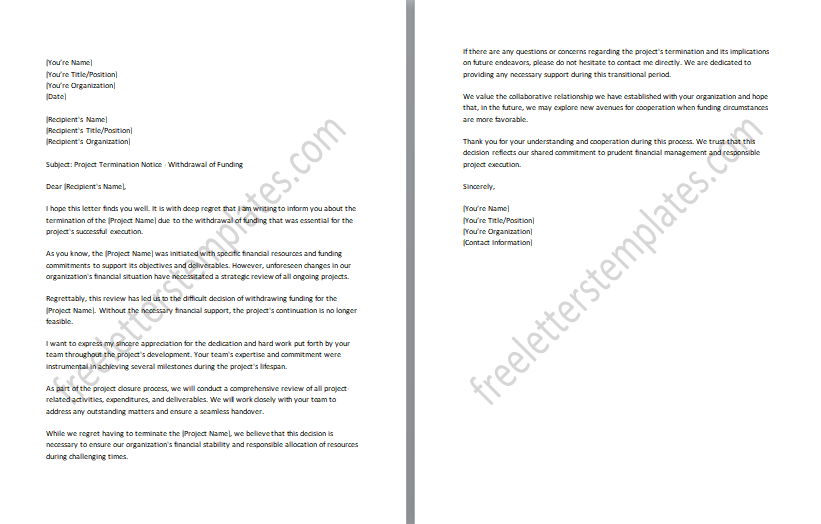
#28: Stakeholder Buy-In Notice
The Stakeholder Buy-In Notice is a formal communication sent by an organization to inform stakeholders about the closure of a project due to the lack of sufficient buy-in from key stakeholders. The notice explains that despite efforts to gain support and alignment, crucial stakeholders have not fully endorsed or committed to the objectives or outcomes. The closure decision is reached after carefully evaluating the feasibility and the potential impact of inadequate buy-in on success. The notice expresses regret for the outcome and appreciation for the team’s dedication. It also acknowledges the collaboration of stakeholders and the initial intent to secure buy-in.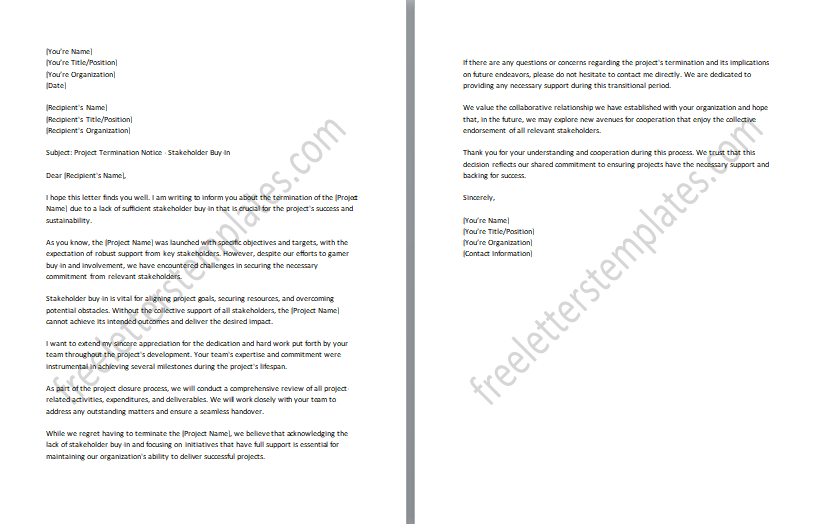
#29: Quality Concerns Project Termination Letter
The Quality Concerns Letter is a formal communication sent by an organization to announce the closure of a project due to significant quality concerns. The decision is reached after careful evaluation and consideration of the viability and potential impact on the organization’s reputation. The letter expresses regret for the decision and appreciation for the team’s dedication. It also acknowledges the collaboration of stakeholders and the initial intent to deliver a high-quality project. The Quality Concerns Termination Letter assures stakeholders that the organization remains committed to learning from the experience and implementing improved quality management practices in future projects.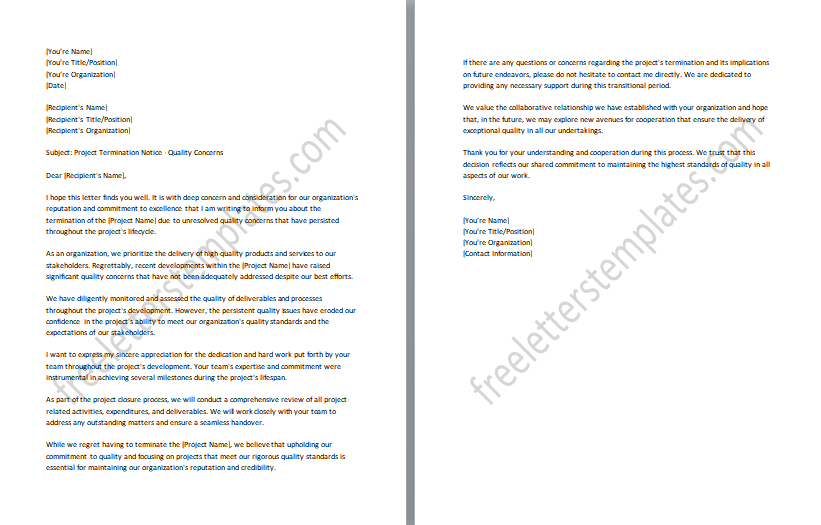
Key Elements of a Project Termination Letter:
- Date: Include the date when the letter is written to provide a reference point.
- Recipient: Address the letter to the appropriate recipient(s), such as stakeholders, clients, team members, or contractors.
- Subject: Clearly state the purpose of the letter in the subject line, mentioning “Project Termination” or similar.
- Salutation: Begin the letter with a respectful salutation addressing the recipient(s) by name, if possible.
- Introduction: Open the letter with a concise and clear statement explaining that the purpose of the letter is to inform about the termination.
- Reason for Termination: Clearly and objectively state the grounds for terminating the project. Use specific and factual language to avoid ambiguity.
- Appreciation: Express gratitude and appreciation for the efforts, dedication, and contributions of the project team and stakeholders.
- Impact on Stakeholders: Acknowledge the potential impact of the termination on stakeholders and demonstrate empathy.
- Next Steps: Communicate any relevant next steps or actions following the termination, such as closeout procedures or transitioning responsibilities.
- Contact Information: Provide contact details for further inquiries or clarifications.
- Closure and Signature: Conclude the letter with a professional closing remark and the sender’s signature.
Structure of a Project Termination Letter:
- Opening: Start the letter with a formal salutation, followed by the date and subject line, clearly stating the purpose.
- Introduction: Begin the letter with a brief introduction, clearly stating that the letter is about the project’s termination.
- Reasons for Termination: Present the reasons for terminating clearly and straightforwardly.
- Appreciation and Acknowledgment: Express appreciation for the efforts and dedication of the project team and acknowledge stakeholders’ collaboration.
- Explanation of Impact: Discuss the potential impact of the termination on stakeholders and assure them their concerns have been considered.
- Next Steps and Closure: Provide information on any follow-up actions, closeout procedures, or responsibilities transition.
- Contact Information: Include contact details for any further questions or inquiries.
- Closing: End the letter with a professional closing remark, such as “Sincerely” or “Best regards,” followed by the sender’s signature and name.
Concluding Thoughts:
In conclusion, “Project Termination Letters” is your celestial gateway to mastering the art of effective and professional communication in the realm of closures. We invite you to explore the boundless resources and guidance we offer to craft letters that shine like stars, leaving lasting impressions on stakeholders and preserving valuable relationships. With our unique and captivating approach, you’ll embark on a stellar journey of transparent, empathetic, and strategic communication, ensuring that every project’s closure paves the way for future constellations of success. Embrace the cosmic power of thoughtful communication, and together, we’ll navigate the celestial skies with confidence, leaving a trail of brilliance in every letter. Join us as we embark on this celestial adventure to elevate your communication to astral heights!